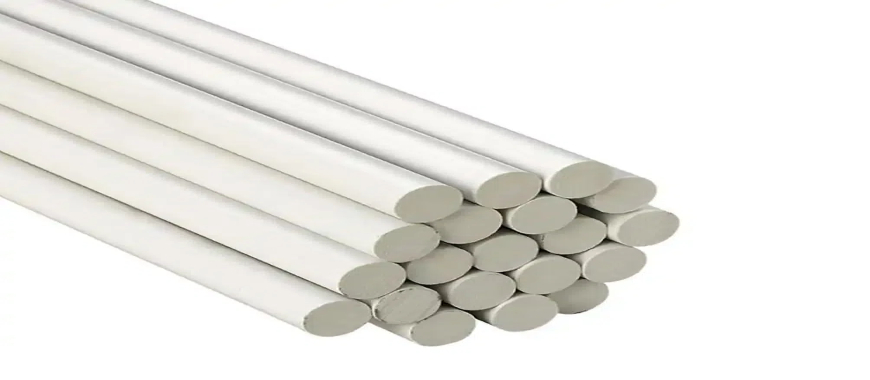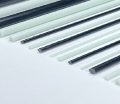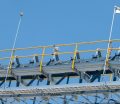
Fiberglass rod fabrication involves crafting strong, lightweight rods from reinforced materials. This process is essential in industries requiring durable and versatile structural components. Fiberglass rods are created to meet precise specifications, offering flexibility for various applications. Their production emphasizes strength, ensuring performance under demanding conditions. These rods are designed to withstand high temperatures, with the fiberglass rod melting point being significantly higher than that of many other materials, making them suitable for use in environments exposed to heat. Widely used in industrial, recreational, and construction projects, these rods address the need for high-performance materials. Fiberglass rods are known for their exceptional strength and durability, making them reliable for long-term use. Their lightweight nature allows easy handling without compromising structural integrity. Additionally, fiberglass rod fabrication produces rods resistant to corrosion, ensuring functionality in harsh environments. These properties make them ideal for diverse industrial and recreational applications.
Types of Fiberglass Rod Fabrications
Solid Fiberglass Rods
Solid fiberglass rods are crafted from high-strength fiberglass materials, offering exceptional durability and rigidity. These rods are primarily used in applications requiring structural support, such as construction projects, industrial frameworks, and custom manufacturing solutions. Their solid structure ensures consistent performance under heavy loads, making them an ideal choice for demanding environments.
In recreational use, solid fiberglass rods are found in hobby crafts, gardening tools, and sports equipment. Their resistance to bending and breaking under stress makes them reliable for projects that require stability. The process of fiberglass rod fabrication ensures that solid rods meet strict quality standards, offering a balance between strength and functionality.
Advantages of Solid Fiberglass Rods
One major advantage of solid fiberglass rods is their superior strength-to-weight ratio. They are lightweight yet capable of bearing heavy loads without compromising performance. Additionally, their resistance to corrosion makes them suitable for outdoor and marine applications. Solid rods are also non-conductive, providing safety in electrical installations. These features demonstrate how fiberglass rod fabrication supports diverse applications across industries.
Common Sizes and Lengths
Fiberglass rods are available in various sizes to cater to specific applications. Popular examples include 10 ft fiberglass rods and 3/4 fiberglass rods, commonly used in construction and hobbyist projects. These sizes are chosen for their versatility, offering the right balance between length and strength.
Selecting the appropriate size involves evaluating project requirements, such as load-bearing capacity and environmental conditions. Longer rods are better for structural applications, while shorter lengths are preferred for portable uses. When creating these rods through fiberglass rod fabrication, manufacturers prioritize precision to meet diverse customer needs.
For instance, 10 ft fiberglass rods are frequently used as tent poles and garden stakes, while 3/4 rods serve as kite supports or reinforcement for small structures. These practical applications highlight how diverse sizes enable tailored solutions for specific needs.
Customization Options
Customization plays a crucial role in fiberglass rod fabrication, enabling users to tailor products to specific dimensions, shapes, and finishes. This flexibility is vital in industries where standard sizes may not meet specialized requirements.
Customized rods ensure optimal performance by addressing unique project demands. For example, adjustable lengths allow for precise installation in confined spaces, while varied diameters accommodate specific load capacities. The process also allows for unique finishes, including UV-resistant coatings for outdoor use. A white fiberglass rod, with its clean appearance and resistance to UV degradation, is often preferred in applications where aesthetics and durability are important.
In addition to these custom options, fiberglass cable fish rods benefit significantly from tailored designs that improve functionality during cable fishing tasks. By adjusting the rod’s flexibility, thickness, or surface finish, users can enhance maneuverability and ensure smoother navigation through conduits and tight spaces. This customization is particularly useful in electrical installations and other wiring projects where precise handling is essential. GangLong Fiberglass specializes in delivering tailored solutions to meet these exacting standards.
Fiberglass Rod Fabrication Process
Materials and Tools Used
The fiberglass rod fabrication process starts with high-quality raw materials, including fiberglass roving and resin. These materials are combined to create rods with excellent strength and flexibility. Pultrusion machines are commonly used to mold the rods, ensuring uniformity and precision. Fiberglass welding rods, like other fiberglass rods, undergo the same careful fabrication process to ensure they meet the demanding requirements of welding applications.
Fabrication requires simple tools like tile saws or hacksaws for cutting. Fine sandpaper is used for smoothing edges and enhancing finishes. Proper tools ensure that the rods maintain their integrity throughout the fabrication process.
The choice of materials significantly affects the performance of fiberglass rods. High-grade resins enhance durability and resistance to environmental factors, while consistent fiberglass content ensures strength. This meticulous selection underscores the importance of reliable fiberglass rod fabrication techniques.
Step-by-Step Fabrication Guide
The fiberglass rod fabrication process involves several critical steps to ensure high-quality results.
- Preparation
Gather raw materials and ensure tools are properly maintained. Safety equipment like gloves and masks should be worn to avoid irritation. - Pultrusion
Fiberglass is pulled through a resin bath, then into a heated die, where it is shaped and cured. This step forms the basic structure. - Cutting
Once cured, rods are cut to the desired length using tile or hacksaws. Precise cutting prevents splintering and ensures clean edges. - Finishing
Sand the rods to smooth the surface and apply protective coatings for enhanced durability. Additional treatments may include UV resistance.
Safety Precautions
Always prioritize safety during fabrication. Use goggles and masks to protect against fiberglass dust. Ensure workspaces are well-ventilated to prevent exposure to fumes. By following these precautions, the fiberglass rod fabrication process can be performed efficiently and safely.
Where to Find Fiberglass Rod for Feeding Wire
Applications of Fiberglass Rod Fabrications
Industrial and Manufacturing Uses
Fiberglass rods play a crucial role in industrial and manufacturing applications due to their high strength and versatility. These rods provide structural support for machinery frameworks, conveyor systems, and assembly lines. Their durability ensures reliable performance under heavy mechanical loads and in demanding environments.
For example, coated fiberglass rods enhance the material’s resistance to corrosion, making them suitable for use in factories exposed to chemicals or moisture. Additionally, these rods are non-conductive, offering safety benefits in industries handling electrical equipment. They are commonly used as insulation supports in electrical plants or as reinforcements in composite panels. At GangLong Fiberglass, we understand the importance of customization and offer tailored solutions to meet specific industrial requirements.
One significant benefit of using fiberglass rods in manufacturing is their lightweight nature, which simplifies installation and reduces strain on equipment. Their long lifespan also minimizes maintenance costs, contributing to greater efficiency. Fiberglass rod fabrication ensures uniform quality, enabling consistent performance across diverse manufacturing applications.
Recreational and Sporting Goods
Fiberglass rods are widely used in recreational and sports applications due to their flexibility and durability. They are commonly found in items like fishing rods, tent poles, and kite frames. These applications demand materials that can withstand repetitive stress without deforming or breaking.
The lightweight and corrosion-resistant properties of fiberglass rods make them ideal for outdoor use. In fishing rods, for example, fiberglass enhances flexibility and strength, allowing them to handle the tension from heavy catches. Similarly, tent poles benefit from their lightweight design, ensuring portability without compromising structural integrity. At GangLong Fiberglass, we pride ourselves on providing rods tailored to these recreational needs.
One major advantage of fiberglass rods in recreational applications is their affordability compared to other materials. They offer a balance between performance and cost, making them accessible for hobbyists and outdoor enthusiasts. Fiberglass rod fabrication ensures precision and reliability, meeting the unique demands of recreational gear.
Infrastructure and Construction
Fiberglass rods are essential in infrastructure and construction projects, where durability and strength are critical. They serve as reinforcements for concrete structures, utility poles, and bridge components. Their corrosion resistance ensures longevity, even in harsh environments like coastal areas or industrial zones.
In construction, fiberglass rod fabrication enables precise customization to fit project specifications. For example, they can be cut to specific lengths or treated with protective coatings for UV resistance. This adaptability makes them a preferred choice for engineers and builders. At GangLong Fiberglass, we offer solutions designed to meet stringent construction standards.
Fiberglass rods are important because they reduce overall structural weight without compromising strength. Their resistance to environmental factors such as moisture and chemicals extends the lifespan of infrastructure. This durability minimizes maintenance, making them a cost-effective choice for large-scale projects.
Sourcing Fiberglass Rods
Finding Suppliers Near You
Locating reliable fiberglass rod fabrication suppliers near you is essential for ensuring quality and timely delivery. Start by researching local vendors specializing in fiberglass products. Visiting their facilities allows you to assess their manufacturing processes and the range of customization options they offer.
When choosing a supplier, consider their experience, certifications, and ability to meet your specific needs. At GangLong Fiberglass, we provide expert guidance to help customers find the perfect rods for their projects. Local sourcing also minimizes shipping costs and lead times, making it a convenient option.
One important factor is the supplier’s ability to provide consistent quality. Ensure they use high-grade materials and follow industry standards in fiberglass rod fabrication. Additionally, inquire about their customization capabilities and lead times to align with your project deadlines.
Step-by-Step Process for a Flawless Fiberglass Rod Finish
Tips for Choosing the Right Fiberglass Rod Fabrication
Factors to Consider
Strength for Load-Bearing Applications
- Strength is a critical consideration for projects involving significant weight or pressure.
- Applications like construction frameworks, industrial machinery supports, and structural reinforcements demand rods with exceptional tensile strength.
- Strong fiberglass rods resist deformation under heavy loads, ensuring reliability and safety in demanding environments.
- Fiberglass rod fabrication enhances strength through precise manufacturing techniques and high-quality materials.
Flexibility for Recreational Uses
- Flexibility is essential for applications that require bending or movement without breaking.
- Fishing rods and tent poles benefit from flexible fiberglass rods, which can withstand repeated stress.
- Flexible rods offer durability in dynamic environments while maintaining lightweight properties.
- Customized fabrication ensures flexibility tailored to the specific needs of recreational products.
Adaptability for Specific Use Cases
- Each project’s requirements influence the choice of rod dimensions, finishes, and coatings.
- For marine environments, rods may need UV-resistant or anti-corrosive treatments to withstand harsh conditions.
- Industrial applications often require heat-resistant coatings for environments with high temperatures.
- Fiberglass rod fabrication offers customization options to address these specific needs effectively.
Tailored Solutions from GangLong Fiberglass
By prioritizing strength, flexibility, and adaptability, we ensure our products meet the highest standards of quality and performance.
At GangLong Fiberglass, we help customers analyze project requirements to select the best fiberglass rod. We provide tailored solutions, including custom lengths, diameters, and finishes, to ensure each rod is perfectly suited to its application.
Budget and Cost Considerations
Balancing quality and affordability is an essential aspect of fiberglass rod fabrication. Budget constraints should not compromise the rod’s durability and functionality. Understanding cost factors can help customers make informed choices.
Material quality and customization significantly impact the price. While higher-grade resins and precise specifications may increase costs, they also enhance performance. At GangLong Fiberglass, we offer competitive pricing for customized solutions, ensuring customers get value for their investment.
For bulk orders, customers often benefit from discounts, making it cost-effective for large projects. Evaluating long-term benefits, such as reduced maintenance costs and improved efficiency, highlights the value of investing in quality rods.
Fiberglass Rod Fabrication: Maintenance and Longevity
Proper Care for Fiberglass Rods
Proper maintenance extends the lifespan of fiberglass rods, preserving their structural integrity and appearance. Routine cleaning is essential, especially for rods exposed to dirt, chemicals, or moisture. Use mild soap and water to clean surfaces, avoiding abrasive materials that might damage the finish.
Storage is another critical factor in ensuring durability. Always store fiberglass rods in a dry, shaded location to protect them from UV damage and temperature extremes. For marine applications, rinse rods with fresh water after exposure to saltwater to prevent corrosive buildup. GangLong Fiberglass emphasizes proper care practices, ensuring our products deliver long-term reliability.
Repairing Fiberglass Rods
Occasionally, fiberglass rods may develop issues like surface scratches or cracks. Addressing these problems promptly can prevent further damage. Small surface scratches can be repaired using fine sandpaper and a protective resin coating. This simple method restores the rod’s smooth finish and protective properties.
For deeper cracks or structural damage, use fiberglass repair kits available in the market. These kits typically include resin and fiberglass fabric for reinforcing weak areas. At GangLong Fiberglass, we guide our customers on effective repair techniques to prolong the life of their rods. Proper repairs ensure that the benefits of fiberglass rod fabrication remain intact throughout the rod’s lifespan.
How to Choose Fiberglass Rod for Plants Brace
The Future of Fiberglass Rod Fabrication
Summary of the Importance of Fiberglass Rod Fabrication
Fiberglass rod fabrication is a cornerstone in modern industries, offering unparalleled strength, durability, and versatility. This process enables the creation of rods tailored to diverse applications, including construction, manufacturing, and recreational uses. The ability to customize rods ensures they meet specific requirements, enhancing their functionality and lifespan.
One key factor in its importance is the material’s resistance to environmental stress. Fiberglass rods are lightweight yet strong, corrosion-resistant, and non-conductive, making them suitable for harsh environments. These qualities contribute to their widespread adoption across industrial and commercial sectors. At GangLong Fiberglass, we emphasize the role of precise fabrication in delivering reliable solutions for our clients’ needs.
Moreover, advancements in fabrication techniques continue to improve the quality and performance of fiberglass rods. From marine settings to high-performance sports equipment, the adaptability of these rods demonstrates the critical role of fiberglass rod fabrication in supporting innovation across industries.
Final Thoughts on Choosing the Right Fiberglass Rod for Your Needs
Selecting the ideal fiberglass rod depends on understanding your specific application requirements. Factors such as strength, flexibility, and environmental exposure play a significant role in determining the most suitable product. Investing in high-quality fiberglass rod fabrication ensures that you benefit from durability, minimal maintenance, and long-term performance.
Customization is a vital consideration, allowing users to tailor rods to precise dimensions and finishes. At GangLong Fiberglass, we pride ourselves on offering bespoke solutions designed to exceed expectations. Whether you need rods for structural support, recreational gear, or unique projects, we help you navigate the decision-making process.
Fiberglass rod fabrication represents a combination of innovation, reliability, and sustainability. By choosing the right materials and fabrication processes, you can unlock the full potential of fiberglass rods, ensuring their optimal performance in any application.
FAQs about Fiberglass Rod Fabrication
Fiberglass rods are made using a process called pultrusion. This involves pulling fiberglass strands through a resin bath to saturate the material. The saturated fibers are then passed through a heated die, which shapes and cures the rod. The heat ensures the resin hardens, creating a durable, lightweight product. Once cured, the rods are cut to specific lengths and may receive additional treatments, such as UV-resistant or anti-corrosive coatings. This fabrication method ensures strength, flexibility, and precision, making fiberglass rods suitable for various applications like construction, recreation, and industrial use.
Yes, fiberglass rods can be sanded to smooth edges, remove imperfections, or prepare the surface for coatings. Use fine-grit sandpaper for a smoother finish and to avoid damaging the fibers. When sanding, it is important to wear protective gear, such as gloves and masks, to avoid contact with fiberglass dust. Sanding should be done gently to preserve the structural integrity of the rod. After sanding, clean the surface thoroughly to remove dust and ensure it is ready for use or further treatments like painting or bonding.
The best way to cut a fiberglass rod is by using a tile saw or a fine-toothed hacksaw. These tools provide clean, precise cuts without causing splintering or damaging the rod. Before cutting, mark the desired length with a marker or tape for accuracy. Ensure the rod is securely clamped to avoid movement during the cutting process. Wearing safety goggles and a mask is essential to protect against fiberglass dust and debris. After cutting, sand the edges to remove any roughness, ensuring the rod is safe to handle.
Fiberglass rods can be joined using strong adhesives, mechanical connectors, or fiberglass sleeves, depending on the application. For adhesive bonding, use a high-strength epoxy specifically designed for fiberglass. Apply the adhesive evenly and press the rods together until the bond sets. Mechanical connectors, such as brackets or clamps, provide a detachable option for joining rods. Fiberglass sleeves are another effective method; they are slid over the joint and secured with adhesive or heat-shrink tubing. Each method ensures a strong connection while maintaining the integrity of the fiberglass material.

As the editor of GangLong Fiberglass, I have years of experience and in-depth research, focusing on cable tray products, fiberglass solutions, and grille systems. I incorporate years of industry insights and practical experience into every content, committed to promoting the progress of the industry. At GangLong Fiberglass, my commitment is reflected in every product, from innovative cable trays to durable fiberglass solutions and sturdy grille systems. As an authoritative voice in the industry, my goal is to provide valuable information to professionals and businesses and promote forward-looking solutions.


